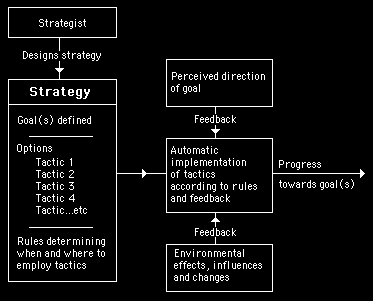
Chapter 15
Communication strategy
The strategy to reach a goal
It is fairly easy to see how experts or specialists might use the Internet environment to help them perform their professional functions. But, they will not have to be concerned with the setting of their main goals in any assignments. This would be the responsibility and concern of a higher level of system organisation represented by the client, boss or employer.
Game Theory would describe these two different levels of organisation as tactical levels and strategic levels. Unlike almost everything else in Game Theory, these levels are hierarchic, where tactics are specified from the higher level of the strategy. This is illustrated in figure 15.3, where the strategist is shown as designing the strategy which defines the goal(s) and tactics. The tactics are then automatically brought into play at the right time or occasion by the rules incorporated in the strategy.

Figure 15.3
Diagram showing how a Game Theory strategy is implemented. Notice that the strategist designs but does not implement the strategy. The implementation is automatic according to feedback from the environment and the perceived progress of the goals(s).
Although a Game Theory strategy can be flexible and adaptable, its composition is quite organised. It consists of a number of possible options and a set of rules (heuristic rules) which specify where or when these options have to be applied. These options are referred to as the tactics of the strategy. Strategists work out the strategy and tacticians take care of the tactics.
Experts and specialists, as collaborators, would be considered to be the tacticians - these are the people who would put into action the options described in the strategy. Entrepreneurs or auteurs, would be the strategists - who would define the goal or goals and create the rules by which the tacticians are brought into play.
There needs to be a subtle, but very important, appreciation of the exact role a strategist plays in Game Theory. It is common to think of the strategist as dynamically employing a strategy to reach a goal. This is not quite the way it works. Once the strategy is designed, it is implemented automatically and the strategists then plays a more passive role - with the tacticians taking over all the action. The only action a strategist might take is to modify the strategy according to its effectiveness and efficiency in reaching the goal(s). Note: Strategists can also act as tacticians to implement their own strategies.
If you think back to the metaphor of the travellers trying to get from Bogota in Columbia to Salvador in Brazil by way of the uncharted tropical rain forest of the Amazon, there is no need for a strategist to be on this journey at all. The reading of the compass and the observation of the celestial bodies would be carried out by tacticians, who would be working to the rules defined by the strategy. A strategist would only be needed if the rules were found wanting; then the strategist would be required to modify the strategy - but not necessarily to implement it.
In stable environments, where there is little change and few unpredictable events, there is little work for a strategist to do once the initial strategy has been designed. In relatively stable business environments, many businesses don't even have strategists: a strategy of a successful operation can be copied by a company that is run solely by tacticians. Many large corporations are organised to run along these lines, where a common strategy is used by many different branches. A chain of multiple stores is a prime example, where practically all employees are tacticians carrying out tasks defined by a common strategy applicable to every different store.